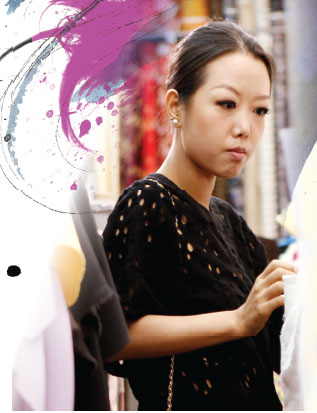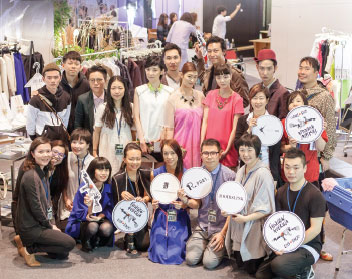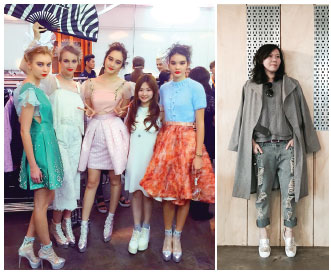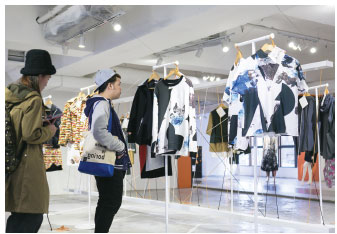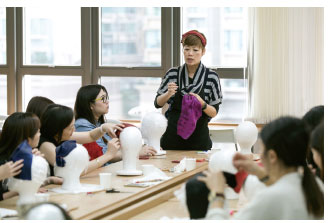Losing out in the fast fashion race
Updated: 2015-07-15 08:10
By Andrea Deng(HK Edition)
|
|||||||
Despite the government push and private initiatives to give HK's deflated fashion design industry a boost, local designers find it difficult to compete with the mighty foreign pr��t brands. Andrea Deng reports.
Talented designers are finding it tough to compete with the overwhelming popularity of fast fashion brands in Hong Kong.
Time was when Hong Kong fashion would set trends elsewhere in Asia. The downward swing began in the 1990s. There is, however, no dearth of talent in the fashion design circuit.
Both the government and the private sector seem keen to give young designers looking for funding and business knowhow a head start. Financial Secretary John Tsang announced a HK$500 million fund that would identify and sponsor local talents earlier this year.
On July 13, the Advisory Group on Implementation of Fashion Initiatives (Fashion Advisory Group) was established, with Victor Lo as its chairman. The Fashion Advisory Group includes 18 non-official members comprising representatives of fashion, design, clothing and textiles sectors and academic institutions.
The Fashion Farm Foundation (FFF), a non-profit organization founded in 2012, offers low-rent co-working space for fashion startups, and facilitates meetings between local designers and international showrooms at fashion events held overseas.
In the event of a business tie-up resulting from such meetings, FFF helps promote the designers internationally.
Nichol Kong, chief manager of FFF, said about a quarter of local Hong Kong designers the foundation brought overseas got a deal with these international showrooms.
And there is The Mills, an industrial building owned by Nan Fung Group, which will soon be converted into a fashion designers' workshop center - giving emerging designers unable to rent a studio or a workshop an affordable space to work from.
A major stumbling block in the way of reviving or promoting Hong Kong designer labels is the proliferation of outlets selling fast fashion brands imported from the US, UK and South Korea. The competition for a slice of the market is much more intense than ever before.
Local versus global
Competitive pricing, convenient store locations and a large quantity of trendy fashion items trickled down from the international runways are some of the things fast fashion brands have going for them.
"First it was the craze over South Korean fashion, which everybody seemed to be wearing. Then came the crazy growth of fast fashion brands. There's almost no space for local fashion design left to breathe," said 31-year-old fashion designer Kei Hui, whose label Crature de Keis has earned him some local acclaim.
Hui is part of a new generation of local fashion designers popping up in the style pages, in fashion magazines and on blogs highlighting the latest design offerings. His design is full of energy and originality, as certain fashion critics say. He is known for using a wide variety of materials and bold colors. He has used mesh neoprene to make oversized, transparent tops that looks like fish net, which one can wear over a tank top or just an undergarment. Some of these have strings woven into the texture and dangling from the mesh.
"I think Hong Kong design has always been quite bold," veteran fashion designer William Tang Tat-chi told China Daily. "Hong Kong designers have the guts to go for their own ideas and signature styles. They don't blindly follow trends that have trickled down from the international runways."
Kong of the FFF concurred, saying that mature designer brands in Hong Kong are able to deliver designs that are creative, unique as well as marketable.
Yet Tang is anxious on behalf of these newer local designers. "I'm worried about how they're going to face the overwhelming market saturation of the international fast fashion brands. It's going to be very tough for budding local designers to compete with them and even to make themselves known," he said.
The American fast fashion brand, Forever 21, made its Hong Kong debut back in January 2012, occupying six floors in Jardine's Bazaar, one of the most-favored shopping locations in Causeway Bay.
Topshop opened its first Hong Kong store in June 2013. The British fast-fashion conglomerate now has three stores - in Lab Concept, Admiralty, Times Square, Causeway Bay and a flagship store near Lan Kwai Fong, Central.
Just across Queen's Road from Topshop, Spanish fashion retailer Zara took over the six-storey shopping space covering 55,000 square feet, previously occupied for nearly a decade by the Swedish fast fashion behemoth H&M.
"Many considered (fast fashion) a more affordable and easily adaptable version of catwalk clothes for the masses," said Wessie Ling, a cultural historian who studied fine art at Central Saint Martin's College of Art and Design and now specializes in the soft power of fashion. "Due to its popularity, consumers, and not just those from Hong Kong, are accustomed to the frequent change of collections in shops, as well as in their wardrobe."
Gone were the days when the wealthy Tai Tai and their socialite daughters, women of power like Lydia Selina Dunn, glamorous icons of popular culture like Anita Mui, would order customized clothing from the local houses of high fashion, said Tang.
"There are two sorts of fashion that were very 'Hong Kong', evening gowns and ladies' office attire. During the 1980s and 1990s, there were so many social functions, the entertainment industry was thriving. And in those days women were climbing the ladders of corporate power and government authority. They were the reason why local fashion design thrived," said Tang.
The city had a distinctive fashion consciousness then, he said, and there was room for local designers to grow. Nowadays, however, it has become socially acceptable for ladies to dress more casually even in special occasions. Light cocktail dresses have replaced the more glamorous nightgowns. Career-centric women could go for brands like COS - a modern chic subsidiary under the Swedish fast-fashion brand H&M - spending less than HK$1,000 for a decent smart-casual dress to be worn at work.
"New generations are less concerned about being identified with a certain fashion identity. Fashion designers are competing with the diversity of fashion offerings globally and locally, online and off it. It is a new era not only for HK but all fashion designers worldwide," Ling argued.
Making magic
Michelle Yeung Lai-ching, this year's overall winner of Young Fashion Designers' Contest, recalled the dramatic transformation in the looks of her mother and aunt when they put on evening gowns to attend social functions or weddings. The "magical power" of apparels felt during her teenage years inspired Yeung to opt for a career in fashion design.
But today even Yeung herself is into fast fashion. Her favorite is the British online fashion and beauty store ASOS. Clothes from ASOS, H&M, and Zara fill up half her wardrobe while the rest is purchased from local boutique stores, which are not necessarily local design.
Yeung said she is 21 and without a stable income to afford more expensive choices yet. She took her degree in fashion design from Hong Kong Polytechnic University last year, and is still exploring and developing her own design signature.
Yeung's own award-winning design is very different from mass-market clothing. Her winning collection, titled "Inside the Cave", was inspired by the stalagmite formations seen in a nature museum in the United States. Slender, transparent beads are sewn together to embellish her clothes. Transparent purse and head accessories in plastic painted with acrylic complete the overall image. She used 16 pieces of fabric to create a voluminous skirt. The entire collection cost her between HK$20,000 and HK$30,000.
The prize for winning the contest includes a trip to Sweden, where H&M is headquartered, and maybe an opportunity to work at the fast fashion powerhouse as a designer.
"I would be really excited to see how the younger generation of Hong Kong designers deliver and define a 'Hong Kong style'," Tang said. "Walking the streets at Central one hears Mandarin-speaking young ladies and they dress well. I wonder how such things might shape 'Hong Kong style' and what Hong Kong designers would make of that."
Tang feels developing a unique "Hong Kong style", would not only make local consumers relate to these designs, it would draw international consumers looking for items they might be unable to find in fast fashion brands.
Hei Lau, a local fashion designer owning an eponymous brand, however, said today's young fashion designers don't have a signature "Hong Kong style" in their designs, because a lot of them were educated overseas and have been exposed to diversified design ideas and culture.
"A good fashion brand must find its own market and customers," said Lau. "Because whether it is a good design or not is really a very subjective thing, some markets like it, some don't. If one of my seasonal collections receives no customers, I would consider that line of design a failure."
Lau decided from the very beginning that she will not target the Hong Kong market, the reasons being that while it is rather small, the rents and overheads are too high. This makes it even tougher for local fashion designers to compete with any established brands.
After five years working with a local fashion retail store, Lau accumulated the business knowhow and decided to establish her own brand, targeting the overseas market. She built a network through participating in overseas trade shows, where she met fashion retailers or department stores interested in Asian designs.
Lau described her new ready-to-wear brand as "simple and fresh elegance". She has persisted in developing her own signature style, which involves a lot of drapery and unusual cuts, rather than looking at the runway trendsetters for inspiration.
"Cliched as it sounds, it always is a question of achieving a balance between marketability and one's own creativity," Lau said.
Contact the writer at andrea@chinadailyhk.com
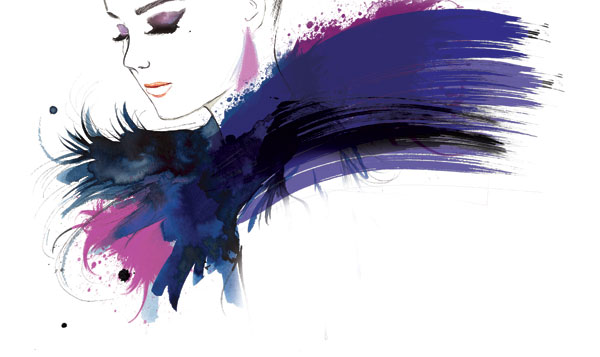
|
Fashion designer Hei Lau decided early on to target the overseas market, reaching out to more global clients. photos provided to China Daily |
|
Fashion Farm Foundation organized the annual Fashion Forward Festival in December 2014, to promote the works of local fashion designers. |
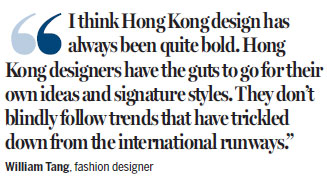
|
Left: Michelle Yeung Lai-ching(second right), this year's overall winner of Young Fashion Designers' Contest, launched her brand Chelle earlier this month.Right: Nichol Kong, chief manager of Fashion Farm Foundation, believes in the talent of Hong Kong fashion designers. |
|
Local designer brands have yet to gain greater recognition among Hong Kong consumers. |
|
Education and training of local fashion design talents have never ceased in Hong Kong, even though the industry started to subside since the second half of the 1990s. |
(HK Edition 07/15/2015 page10)
